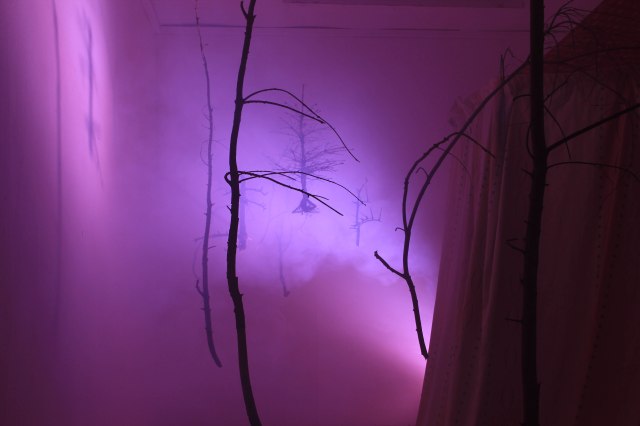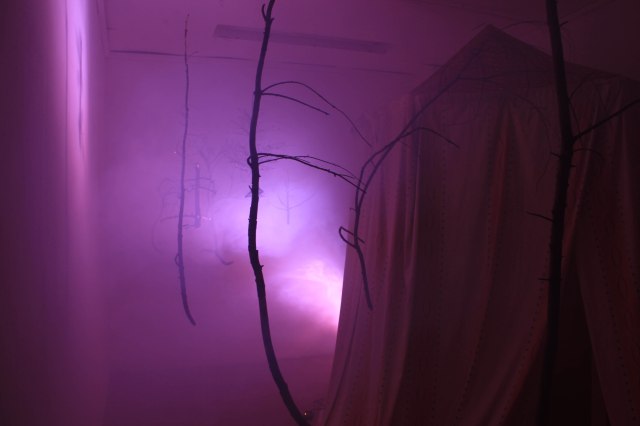The artist kindly emailed me some images and his comments (here in a purple text colour) to compensate me for not seeing his installation.
In recent work I’ve used dark spaces to create immersive atmospheres; at first I thought about blackening out the windows of this space. I was in PS Squared during the summer and realised that the entire room becomes a dark space when the sun goes down, so instead I started planning to do something in winter when the days draw in. I liked that connection with outside.
I wanted to make an atmospheric installation using lighting and smoke that would be a kind of spectacle to passers by, but that would also allow them to see ‘behind the scenes’.
I started by constructing a wooden frame and attaching patterned fabric, which became a tent large enough to walk around inside. I suspended branches and broken trees in mid air, about 4ft off the floor. I placed a smoke machine behind the tent on a 5 minute timer beside a blue-purple floodlight, both of which pointed into the space. I turned off all the other lights.
I was looking for- simple geometry and a kind of aesthetic that relates to Medieval and also Arabian tents. I was in a forest by the Lagan and there was this strange little building, I started to paint it and gradually the building became a tent with a pointed roof. I tend to pick up on an atmosphere before I can rationally explain imagery. There was something that appealed to me about the idea of the cold Northern forest as portrayed for example in Game of Thrones– a mysterious and dangerous place saturated with ancient spirituality. I started thinking of the connotations of tents and temporary structures to the ‘man and landscape’ dynamic; a lightness of living, fitting in to the order of nature rather than altering it, moments of contemplation. The Tent of Meeting was where God met the Israelites in the wilderness; the wilderness was where God often met people. The whole idea is still developing, layers of connotations like layers in a painting, some will have to be covered over and some new ones added
The view from outside after dark presents a cinematic appearance which dissolves upon closer inspection of the materials and technology used; it is visually sensuous while also revealing it’s own illusion.
I also enjoyed thinking about composition and light within a formal space contained by a window frame, in a similar way that I approach painting.
————————————————————————————-
The photographs allow me to see it as a public work of art, yet it is ephemeral and not celebratory of a past event; as a shop window arrangement, yet it is not advertising objects to buy. It works as an immersive, contemplative experience, or a fleeting eye contact treasured in the haste of the running past the window.
The accessibility of the installation , similar to any shop window, approximates one of the conditions for a public work of art, these viewers are not just the usual group attending openings of exhibitions, they are indeed the (abstract/ general) public.
The tent harvests the angular Euclidian geometry, both in its wooden construction and rectangular fabrics, until it arrives to its apex – there the fabric remembers its own pliable character and swirls into a curved opening, a shape of the eternal eye in medieval frescoes.
The installation presents items that have a past. The tent, the smoke, the textile and the dead tree are recycled away from their practical life function.
It is a kind of a transfer of values.
These words are not innocent.
Barnet Newman chastised the Impressionists for being able “…only to make a transfer of values”(The Sublime is Now,1948, reprinted in Herschel B Chipp, Theories of Modern Art, 1968:553). His position was determined by a belief that the American Abstraction at that time was free from outmoded props and antiquated legends:”…the image we produce is the self-evident one of revelation, real and concrete, that can be understood by anyone who will look…”(ibidem). While looking at the selection of still photographs sent to me by John Robinson, I propose that he manages to evoke poetic that is analogical to that self-evident revelation, in addition one that is embracing the history of found objects. Instead of presenting them as obsolete props, the installation weaves them into the immersive poetic environment. Questioning the various elements of the composition in a rectangle of the room leads to the power of the light, the coloured light, the colour.
The public’s encounters with this art are personal experiences, i.e. private. The polarity public-private transforms itself into a kind of booby trapped package (with apology to Susan Sontag), memory of which may delight the soul. The window frame obliges the eye to follow the wonderous geometry that holds together volumes, distances, angles and colours.
The colour(light) is rich, full and somewhat austere, in the sense of being a modulation of one hue. Robinson shares this maroon – like hue with Barnet Newman. With Wassily Kandinsky he shares the conviction of colours unifying force, by which I mean binding diverse elements into a unity of being. The anecdotal evidence of Kandinsky “walking into a picture” when visiting a peasant’s house is further worked out by his theoretical musing in his The effect of colour, 1911: ” …colour is the keyboard, the eyes are the hammers, the soul is the piano with many strings. The artist is the hand that plays….”( op cit. 155). The artist has to find the “white, fertilizing ray” – that is to know what is specifically necessary for a given work of art. Rehearsing that task in public is a generous offer of an insight into a multitude of possible connections and associations still not managing to kill of a purple reverie.
More on Rehearsal Room projects see http://www.pssquared.org/rehearsalroom.php










Reblogged this on johnmichaelrobinson.
LikeLike